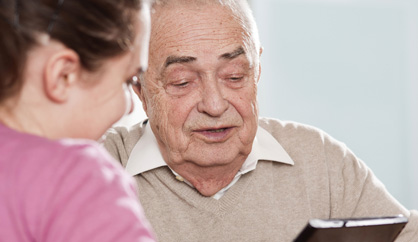Health and home

Virtual wards aim to reduce hospital readmissions; take a closer look at approaches in Australia and the UK.
In the UK, virtual wards in the home are already in use. They have been employed with varying degrees of success. Now the question is being asked – what can Australia learn from this?
Virtual wards take the staffing, systems and daily routines of a hospital ward environment and translate them into home care. They have been set up in areas of the UK to reduce patient readmissions. Patients who are predicted to be at risk of readmission in the next 12 months are offered the service.
Rebecca Disler, lecturer in nursing and director of international activities at the University of Technology, Sydney, says the evidence surrounding the success of virtual wards is mixed when it comes to lowering readmissions. Still, she says in terms of an approach to delivering care and hospital avoidance, she can see the potential for the wards in Australia, even if they just remove a geographical barrier.
“We know the people who are most commonly admitted to hospital are people with chronic disease and multiple comorbidities,” Disler says. “These people are often physically debilitated, so travelling to hospital is difficult. If we can intervene early, then we can potentially reduce hospital admissions and the progression of disease. But the jury’s still out in terms of whether they truly work.”
A project led by Dr Geraint Lewis by the UK-based Nuffield Trust – Examining the Effectiveness of Virtual Wards – reveals a mixed bag.
Lewis found no evidence of a reduction in emergency hospital admissions for patients who received care within a virtual ward in six months after starting the intervention, compared with matched controls. The research also found no evidence in ambulatory care sensitive hospital admissions or mortality in the same period.
The team did observe, however a reduction in elective hospital admissions and outpatient attendances.
The report suggests that health service providers should focus on what it means to be a virtual ward and stated that analyses showed many of the patients who were admitted to these wards had highly complex illnesses with important implications for social care.
Disler says the idea of a virtual ward incorporates integrated, co-ordinated and complex care. “That’s best practice, coming from a chronic care model of having an interdisciplinary, multidisciplinary team, with stronger collaboration between community, primary and secondary tertiary care, and having as part of that an engaged patient cohort,” she says. “We know that having someone [be] an engaged and active participant in their own healthcare improves outcomes and I think the idea of having a virtual ward where you can deliver care within someone’s home in a timely manner feeds into that as well.”
Disler says there is great capacity for using virtual wards with online delivery in Australia.
She says people are already using platforms and media such as online health sites to find information or peer networks to understand their condition. “We have an opportunity as health professionals to engage with that and better provide and direct people into that space to find quality advice and information.”
Disler also says more of this peer networking and social support would add to the virtual ward framework to improve its effectiveness. “We can’t replicate that kind of support as healthcare professionals.”
As an example, Disler says the issue with the state of virtual wards in the UK is that they involve small cohorts of patients.
“If you’re going to be using one highly skilled professional to deliver care to a limited number of individuals then that is going to limit your applicability,” she explains. “Maybe we need to change the approach and look at [making] this about delivering healthcare to a larger number of people and engaging them with sites and peer networks.
“We need to look more closely at the social aspects, we need to look more closely at connectedness and how we use social support and peer networking to bolster what we can do as healthcare professionals. At some point we have to figure out how we can deliver healthcare to a large population.
“There is no necessarily sustainable healthcare network in this form, so we are going to have to think about innovative ways of using our resources in a more efficient way and delivery to a larger population.”
At the same time, she adds, the idea of targeting people likely to readmit to hospital makes logical sense. “If you manage people earlier, if you provide good services, then they’re less likely to come into hospital,” she says and adds building on what the UK has done is an option.
“[The UK model] delivers care to the person and it’s timely as well,” she explains. “People are not having to wait to go into hospital or wait for six months for their specialist appointment, they’re getting timely accessible advice and care. It certainly has all the hallmarks of something that will work.”
Australia already has a similar service, Hospital in the Home (HITH). This involves experienced clinical nurses and allied health staff managing and assessing patients in the community, providing similar or the same level of care as people would receive in hospital. This may include administering intravenous antibiotics for serious wounds that require daily care or other observational or clinical needs.
The staff take the usual biomedical equipment out to patients as well as point-of-care machines. Some services also have high-tech equipment for assessments such as cardiac monitoring.
Anna MacDonald, nurse unit manager for a Hospital in the Home service, says nurses can be out in the community and log into the patient’s electronic medical record to see what a doctor might have written beforehand, such as new drug orders.
“We can view in real time the drug chart that’s being scanned in and use that for authorisation, rather than having to have the hard copy out with us,” MacDonald says. “We can also view the patient’s pathology results by using the remote hook-up.”
MacDonald says some services are talking a lot about combining telehealth with HITH services. “Telehealth would be good because sometimes you might want the doctor right there to talk to the patient or look at the wound or a situation,” she says. “It’s face-to-face, and x-rays can be reviewed between the GP and the doctors … but the technology is a bit tricky,” she says.
“Our staff have laptops they take out to the home, though there are problems with the connections,” MacDonald adds. “We need better connection for out laptops or if we end up going to tablets we need there to be smoother, more efficient connections.
“The staff can write up their notes and ask a doctor to review it, or in theory we should be able to take wound photos when we’re out in the community and plug them straight into the system but because we have problems with connectivity it’s difficult at the moment.”
In terms of measuring a reduction in hospital readmissions due to HITH, MacDonald says establishing accurate percentages is difficult, as only the more complex patients would need to go onto the HITH service. However, she says patients want to be home and don’t want to come back into hospital, so the service is beneficial for them. The HITH team is hoping to see a wider range of clients in the future.
Studies by associate professor Gideon Caplan, who helped found HITH, on the benefits of the service have shown fewer adverse outcomes for patients and increases in staff and patient satisfaction, MacDonald adds.
“The staff enjoy the opportunity to be autonomous and more responsible for the patients,” she says. “It’s hard to get a job in our service because no one really ever moves on.”
Email: [email protected]





